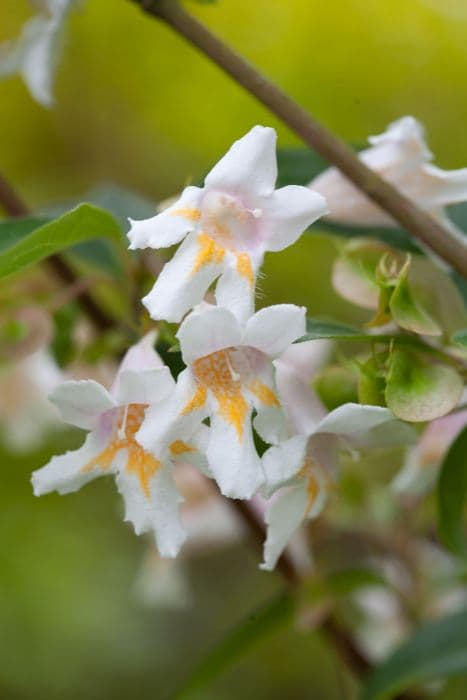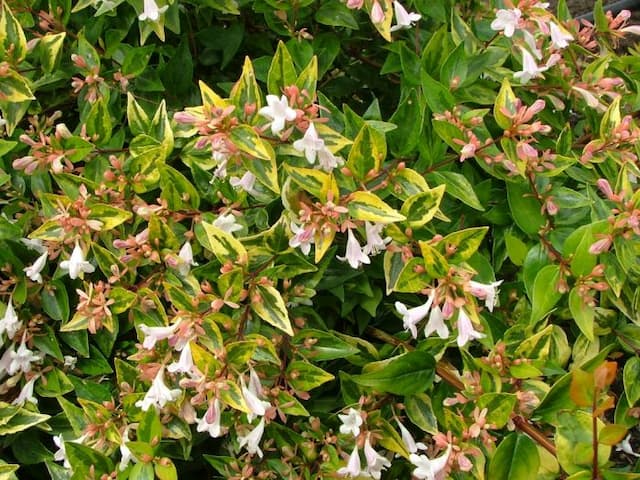Chinese Dipelta Dipelta ventricosa

ABOUT
Dipelta ventricosa, also known as Dipelta, is a visually appealing flowering shrub. Its most striking feature is the profusion of flowers it displays during the blooming season. The flowers have a captivating form, with flaring petals that create an almost trumpet-like silhouette, and they usually come in soft, pastel hues that can range from white to pale pink. This ornate blooms may also exhibit subtle yellow throats, adding a dash of bright color that contrasts beautifully with the softer tones of the petals. Dipelta ventricosa has a rounded and bushy growth habit, making it an attractive choice for ornamental gardens. Its leaves are equally charming, with a lush and dense foliage that provides a deep green backdrop for the delicate flowers. The leaves are shaped with an undulating margin, giving them a slightly textured look and feel. Some may even have a softly hairy surface, adding to the tactile experience of the plant. During fall, the foliage may turn to shades of yellow, bringing seasonal interest as the garden transitions to cooler weather. Additionally, after the flowers have bloomed, the shrub produces inconspicuous fruit that usually goes unnoticed amidst the dense foliage. Overall, Dipelta ventricosa captures attention primarily during its flowering period with its ornamental blooms that contribute to the aesthetic appeal of any garden space.
About this plant
 Names
NamesFamily
Caprifoliaceae.
Synonyms
There are no widely recognized common names for Dipelta ventricosa.
Common names
Dipelta ventricosa.
 Toxicity
ToxicityTo humans
Dipelta ventricosa, commonly known as Dipelta, does not have a well-documented profile of toxicity to humans in scientific literature as of my last knowledge update. There are no widespread reports of poisoning or adverse effects. However, it is always advisable to exercise caution and avoid ingesting plants not known to be edible, as they may contain compounds that could be harmful if consumed. If a person suspects they have been poisoned by any plant, they should seek medical attention.
To pets
Dipelta ventricosa, also known simply as Dipelta, is not commonly known to be toxic to pets. However, the absence of documented toxicity does not guarantee that a plant is safe. Pets may have different sensitivities to plants compared to humans. If a pet ingests part of a Dipelta plant and shows signs of distress or illness, it is essential to consult a veterinarian immediately. Keep in mind that symptoms of poisoning in pets can include vomiting, diarrhea, drooling, weakness, or unusual behavior.
 Characteristics
CharacteristicsLife cycle
Perennials
Foliage type
Deciduous
Color of leaves
Green
Flower color
Pink
Height
6-8 feet (1.8-2.4 meters)
Spread
6-8 feet (1.8-2.4 meters)
Plant type
Shrub
Hardiness zones
5
Native area
China
Benefits
 General Benefits
General Benefits- Landscape Aesthetics: Adds beauty and visual interest to gardens with its showy flowers and attractive foliage.
- Habitat for Wildlife: Provides food and shelter for various species of birds, insects, and other wildlife.
- Erosion Control: Can help stabilize soil and reduce erosion when planted on slopes or banks.
- Privacy Screening: Grows to a substantial size, making it useful for creating privacy screens in residential areas.
- Shade Production: Its canopy can offer shade in gardens or patios, creating cooler areas during warm seasons.
- Seasonal Interest: Offers seasonal changes in color and form, contributing to the year-round appeal of a landscape.
- Pollinator Attraction: Flowers attract bees, butterflies, and other pollinators, supporting biodiversity.
 Medical Properties
Medical PropertiesThis plant is not used for medical purposes.
 Air-purifying Qualities
Air-purifying QualitiesThis plant is not specifically known for air purifying qualities.
 Other Uses
Other Uses- Crafting Material: Branches of Dipelta ventricosa can be used in floral arrangements and wreath-making for their aesthetic appeal.
- Dye Production: The bark or leaves of the shrub might be used to produce natural dyes for fabrics or crafts.
- Perfumery: The fragrant flowers could potentially be processed to create essential oils for perfumes or aromatherapy products.
- Garden Design: This plant is often used in ornamental horticulture to create picturesque landscapes and garden focal points.
- Erosion Control: Dipelta ventricosa can be planted on slopes or banks to help prevent soil erosion with its root system.
- Windbreaks: Tall specimens can be used in a line to act as windbreaks to protect smaller, more delicate plants in the garden.
- Butterfly Garden: Its flowers are attractive to butterflies, making it a suitable choice for butterfly gardens to promote biodiversity.
- Photography: Dipelta ventricosa's intriguing flowers are excellent subjects for botanical photography and illustration due to their unique appearance.
- Botanical Studies: The plant can be used for educational purposes in universities and botanical gardens to study plant morphology and adaptation.
- Privacy Screen: When planted in a dense row, it can function as a natural privacy screen in residential garden settings.
Interesting Facts
 Feng Shui
Feng ShuiThe Dipelta ventricosa is not used in Feng Shui practice.
 Zodiac Sign Compitability
Zodiac Sign CompitabilityThe Dipelta ventricosa is not used in astrology practice.
 Plant Symbolism
Plant Symbolism- Rarity: Dipelta ventricosa, commonly known as simply Dipelta, is not well-known or common, symbolizing the unique and the rare in life.
- Exclusivity: Due to its relative obscurity in horticulture, the Dipelta can symbolize an exclusive element or aspect that isn't available to everyone.
- Beauty in Isolation: As a less common plant, the Dipelta may symbolize the concept that beauty can exist in isolation and does not always need to be widely recognized to be appreciated.
 Water
WaterBeautibush should be watered thoroughly, ensuring the soil is moist but not soggy. During the growing season, it typically requires watering once a week, but you should adjust frequency based on weather conditions and soil drainage. Always check the top inch of soil for dryness before watering. You may scale back watering in the winter months to every two weeks or when the soil is dry to touch. On average, use approximately one gallon of water per watering session for a medium-sized shrub, ensuring even distribution around the base of the plant.
 Light
LightBeautibush thrives in full sun to partial shade conditions. It should be planted in a spot where it can receive at least four to six hours of sunlight each day. Dappled sunlight or afternoon shade is beneficial in hotter climates to protect the leaves from scorching.
 Temperature
TemperatureBeautibush prefers a temperate climate and is hardy in a range of temperatures. It can withstand minimum temperatures down to about 20 degrees Fahrenheit. The ideal temperature range for optimal growth is between 60 and 75 degrees Fahrenheit, though it can survive short periods of higher or lower temperatures.
 Pruning
PruningBeautibush should be pruned to maintain shape and encourage vigorous growth. Prune in late winter or early spring before new growth begins. Remove any dead or damaged branches, and cut back up to one-third of the oldest stems to promote fresh growth. Pruning can be done annually or as needed to keep the plant looking tidy.
 Cleaning
CleaningAs needed
 Soil
SoilThe best soil mix for the Chinese Dipelta is one that is well-draining with a good amount of organic material, such as a blend of loam, peat, and sand. The soil pH should be slightly acidic to neutral, in the range of 6.0 to 7.5.
 Repotting
RepottingChinese Dipelta should be repotted every two to three years to refresh the soil and accommodate root growth. It is best repotted in the spring before new growth begins.
 Humidity & Misting
Humidity & MistingChinese Dipelta thrives in moderate humidity levels. Aim for a humidity level around 40-50% for optimal growth. Avoid excessively dry or overly humid conditions.
 Suitable locations
Suitable locationsIndoor
Ensure bright, indirect light, and keep soil slightly moist.
Outdoor
Plant in partial shade and well-draining soil; protect from strong winds.
Hardiness zone
5-7 USDA
 Life cycle
Life cycleThe life cycle of Dipelta ventricosa, commonly known as Beautiful Dipelta, begins with the dispersal of seeds, which generally occurs through wind or animal mediation. After successful seed germination, which requires appropriate temperature and moisture conditions, a seedling emerges and establishes roots. The plant then enters a vegetative growth stage, developing leaves and stems. As the Beautiful Dipelta matures, it develops its characteristic trumpet-shaped flowers in late spring to early summer, which are pollinated by insects. Following pollination, the plant produces fruit, typically a capsule containing seeds that eventually disperse to begin a new cycle. The Beautiful Dipelta then either enters a period of dormancy in colder climates or continues to grow vegetatively in favorable conditions, completing its life cycle over several years.
 Propogation
PropogationPropogation time
Spring-early summer
Dipelta ventricosa, commonly known as dipelta, is propagated most effectively through semi-hardwood cuttings. This process is typically performed in late summer after the current year's growth has started to mature and harden slightly. To propagate, a gardener would cut a 4 to 6-inch (10 to 15 centimeters) long piece of stem that includes several leaf nodes. Leaves on the lower half of the cutting are removed, and the cut end is then dipped in rooting hormone to encourage root development. The treated cutting is inserted into a well-draining potting mix, with at least two nodes buried in the soil to maximize the potential root growth areas. The pot is kept in a warm, humid environment, often under a plastic dome or in a greenhouse, to maintain moisture levels and warmth, which are vital for root development. Within a few weeks to a couple of months, if conditions are optimal, the cutting should begin to root and can eventually be transplanted into the garden.

![Abelia [Sunshine Daydream]](/_next/image?url=https%3A%2F%2Fplants-admin.emdemapps.com%2Fimages%2Fplants%2F%2Fimages%2F604b61a1e9cdd.png&w=640&q=75)







